brake sensor HONDA ODYSSEY 2022 Owners Manual
[x] Cancel search | Manufacturer: HONDA, Model Year: 2022, Model line: ODYSSEY, Model: HONDA ODYSSEY 2022Pages: 782, PDF Size: 27.17 MB
Page 7 of 782
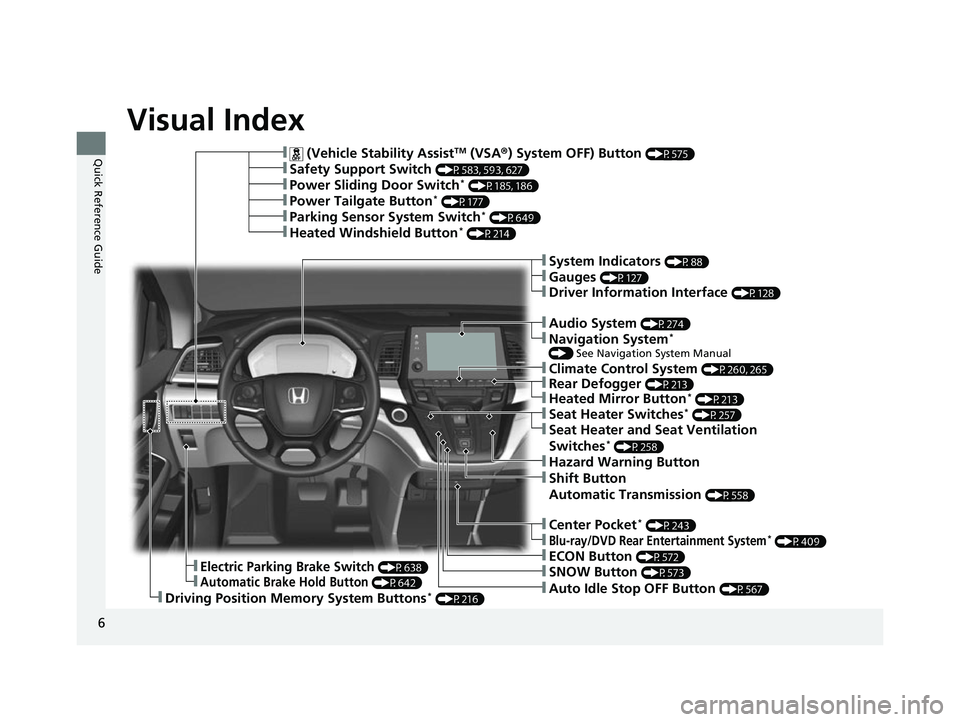
6
Quick Reference Guide
Quick Reference Guide
Visual Index
❚ (Vehicle Stability AssistTM (VSA®) System OFF) Button (P575)
❚Power Sliding Door Switch* (P185, 186)
❚Power Tailgate Button* (P177)
❚Climate Control System (P260, 265)
❚Driving Position Memory System Buttons* (P216)
❚Parking Sensor System Switch* (P649)
❚Heated Windshield Button* (P214)
❚Safety Support Switch (P583, 593, 627)
❚Electric Parking Brake Switch (P638)
❚Automatic Brake Hold Button (P642)
❚Shift Button
Automatic Transmission
(P558)
❚ECON Button (P572)
❚SNOW Button (P573)
❚Auto Idle Stop OFF Button (P567)
❚Hazard Warning Button
❚System Indicators (P88)
❚Gauges (P127)
❚Driver Information Interface (P128)
❚Audio System (P274)
❚Navigation System*
() See Navigation System Manual
❚Rear Defogger (P213)
❚Heated Mirror Button* (P213)
❚Seat Heater Switches* (P257)
❚Seat Heater and Seat Ventilation
Switches* (P258)
❚Center Pocket* (P243)
❚Blu-ray/DVD Rear Entertainment System* (P409)
22 US ODYSSEY-31THR6400.book 6 ページ 2020年11月16日 月曜日 午後1時41分
Page 30 of 782
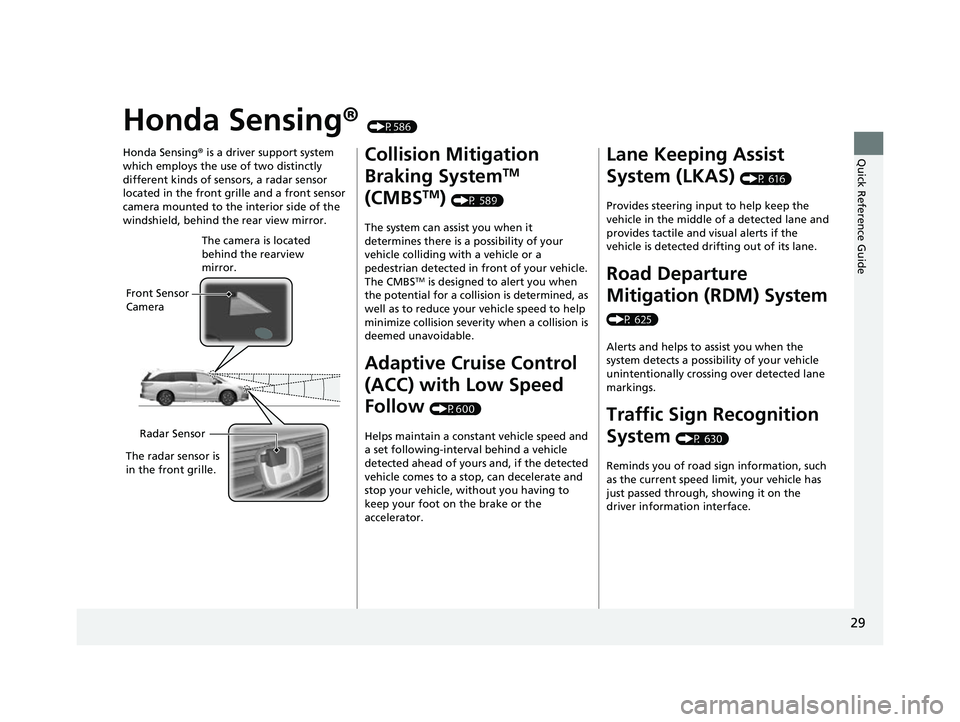
29
Quick Reference Guide
Honda Sensing® (P586)
Honda Sensing ® is a driver support system
which employs the use of two distinctly
different kinds of sensors, a radar sensor
located in the front grille and a front sensor
camera mounted to the interior side of the
windshield, behind the rear view mirror.
Front Sensor
Camera The camera is located
behind the rearview
mirror.
Radar Sensor
The radar sensor is
in the front grille.
Collision Mitigation
Braking System
TM
(CMBS
TM) (P 589)
The system can assist you when it
determines there is a possibility of your
vehicle colliding with a vehicle or a
pedestrian detected in front of your vehicle.
The CMBS
TM is designed to alert you when
the potential for a collision is determined, as
well as to reduce your vehicle speed to help
minimize collision severity when a collision is
deemed unavoidable.
Adaptive Cruise Control
(ACC) with Low Speed
Follow
(P600)
Helps maintain a constant vehicle speed and
a set following-interval behind a vehicle
detected ahead of yours and, if the detected
vehicle comes to a stop, can decelerate and
stop your vehicle, without you having to
keep your foot on the brake or the
accelerator.
Lane Keeping Assist
System (LKAS)
(P 616)
Provides steering input to help keep the
vehicle in the middle of a detected lane and
provides tactile and visual alerts if the
vehicle is detected drifting out of its lane.
Road Departure
Mitigation (RDM) System
(P 625)
Alerts and helps to assist you when the
system detects a possibility of your vehicle
unintentionally crossing over detected lane
markings.
Traffic Sign Recognition
System
(P 630)
Reminds you of road sign information, such
as the current speed limit, your vehicle has
just passed through, showing it on the
driver information interface.
22 US ODYSSEY-31THR6400.book 29 ページ 2020年11月16日 月曜日 午後1時41分
Page 91 of 782

90
uuIndicators u
Instrument Panel
IndicatorNameOn/BlinkingExplanationMessage
Parking Brake
and Brake
System Indicator
(Amber)
•Comes on if there is a problem
with the radar sensor.
• Indicator may come on
temporarily when the Maximum
Load Limit is exceeded.•Make sure the total lo ad is within the
Maximum Load Limit.
2 Maximum Load Limit P. 541
•Stays on constantly - Have your
vehicle checked by a dealer.
—
U.S.
Canada
(Amber)
22 US ODYSSEY-31THR6400.book 90 ページ 2020年11月16日 月曜日 午後1時41分
Page 127 of 782
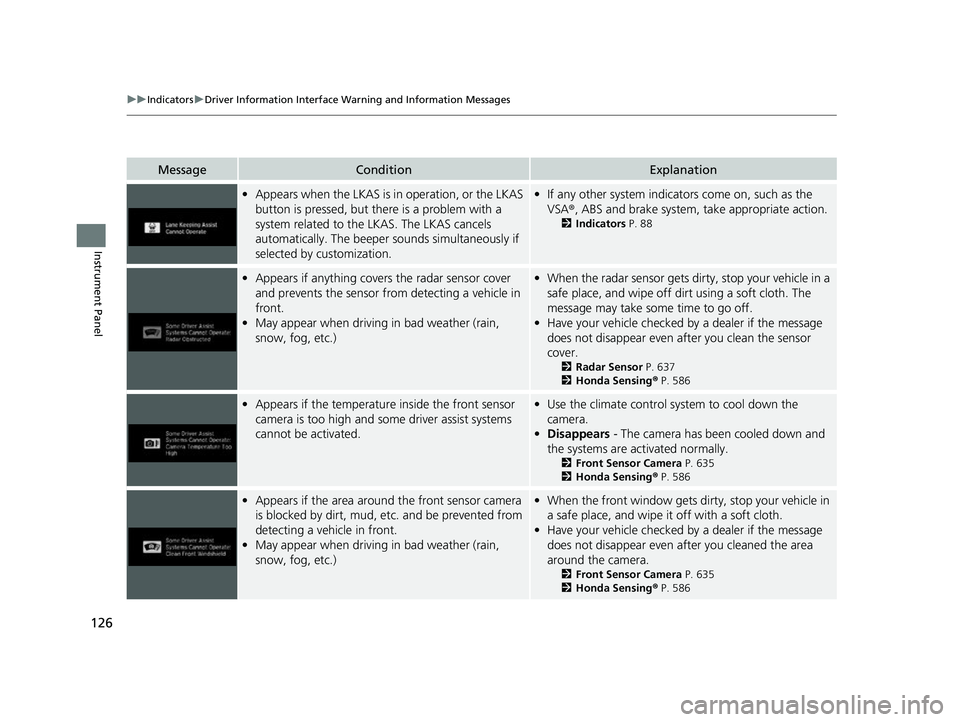
126
uuIndicators uDriver Information Interface Wa rning and Information Messages
Instrument Panel
MessageConditionExplanation
•Appears when the LKAS is in operation, or the LKAS
button is pressed, but there is a problem with a
system related to the LKAS. The LKAS cancels
automatically. The beeper s ounds simultaneously if
selected by customization.• If any other system indicators come on, such as the
VSA ®, ABS and brake system, take appropriate action.
2Indicators P. 88
•Appears if anything covers the radar sensor cover
and prevents the sensor from detecting a vehicle in
front.
• May appear when driving in bad weather (rain,
snow, fog, etc.)•When the radar sensor gets dirty, stop your vehicle in a
safe place, and wipe off dirt using a soft cloth. The
message may take some time to go off.
• Have your vehicle checked by a dealer if the message
does not disappear even after you clean the sensor
cover.
2 Radar Sensor P. 637
2 Honda Sensing ® P. 586
• Appears if the temperature inside the front sensor
camera is too high and some driver assist systems
cannot be activated.•Use the climate control sy stem to cool down the
camera.
• Disappears - The camera has been cooled down and
the systems are activated normally.
2 Front Sensor Camera P. 635
2 Honda Sensing ® P. 586
• Appears if the area around the front sensor camera
is blocked by dirt, mud, etc. and be prevented from
detecting a vehicle in front.
• May appear when driving in bad weather (rain,
snow, fog, etc.)•When the front window gets dirty, stop your vehicle in
a safe place, and wipe it off with a soft cloth.
• Have your vehicle checked by a dealer if the message
does not disappear even after you cleaned the area
around the camera.
2 Front Sensor Camera P. 635
2 Honda Sensing ® P. 586
22 US ODYSSEY-31THR6400.book 126 ページ 2020年11月16日 月曜日 午後1時41分
Page 538 of 782
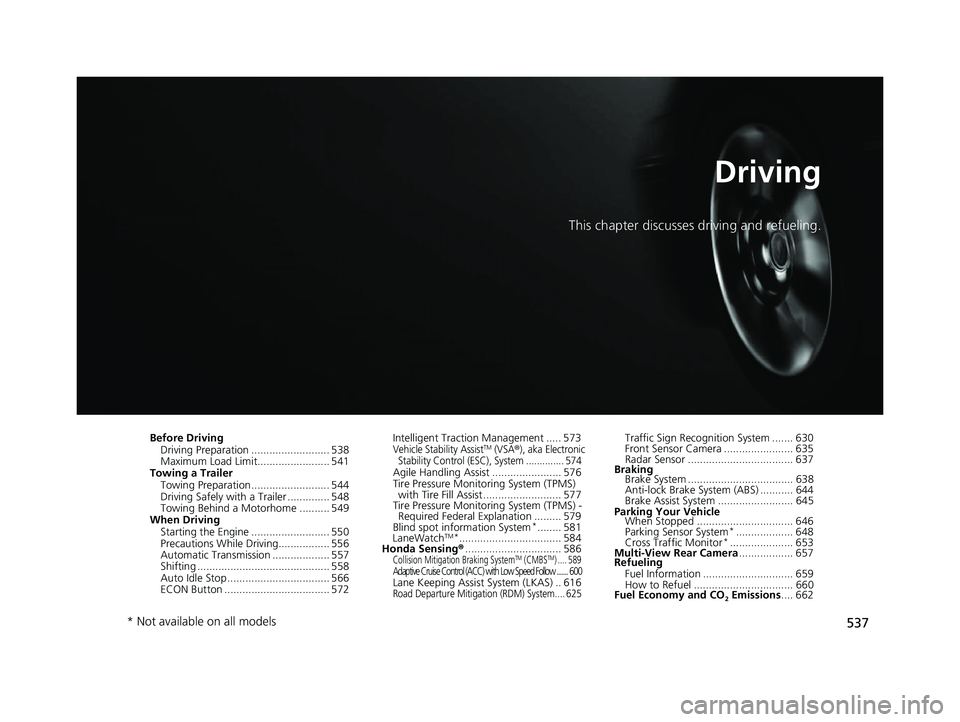
537
Driving
This chapter discusses driving and refueling.
Before DrivingDriving Preparation .......................... 538
Maximum Load Limit........................ 541
Towing a Trailer
Towing Preparation .......................... 544
Driving Safely with a Trailer .............. 548
Towing Behind a Motorhome .......... 549
When Driving
Starting the Engine .......................... 550
Precautions While Driving................. 556
Automatic Transmission ................... 557
Shifting ............................................ 558
Auto Idle Stop .................................. 566
ECON Button ................................... 572 Intelligent Traction Management ..... 573Vehicle Stability AssistTM (VSA®), aka Electronic
Stability Control (ESC), System .............. 574
Agile Handling Assist ....................... 576
Tire Pressure Monitoring System (TPMS) with Tire Fill Assist .......................... 577
Tire Pressure Monitoring System (TPMS) - Required Federal Explanation ......... 579
Blind spot information System
*........ 581
LaneWatchTM*.................................. 584
Honda Sensing ®................................ 586
Collision Mitigation Braking SystemTM (CMBSTM) .... 589Adaptive Cruise Control (ACC) with Low Speed Follow ....... 600Lane Keeping Assist System (LKAS) .. 616Road Departure Mitigation (RDM) System.... 625
Traffic Sign Recognition System ....... 630
Front Sensor Camera ....................... 635
Radar Sensor ................................... 637
Braking Brake System ................................... 638
Anti-lock Brake System (ABS) ........... 644
Brake Assist System ......................... 645
Parking Your Vehicle When Stopped ................................ 646
Parking Sensor System
*................... 648
Cross Traffic Monitor*..................... 653
Multi-View Rear Camera .................. 657
Refueling
Fuel Information .............................. 659
How to Refuel ................................. 660
Fuel Economy and CO
2 Emissions .... 662
* Not available on all models
22 US ODYSSEY-31THR6400.book 537 ページ 2020年11月16日 月曜日 午後1時41分
Page 590 of 782

589
uuHonda Sensing ®u Collision Mitigation Braking SystemTM (CMBSTM)
Continued
Driving
Collision Mitigation Braking SystemTM (CMBSTM)
The system can assist you when it determines there is a possibility of your vehicle
colliding with a vehicle or a pedestrian dete cted in front of your vehicle. The CMBSTM
is designed to alert you when the potential for a collision is determined, as well as to
reduce your vehicle speed to help minimize collision severity when a collision is
deemed unavoidable.
1 Collision Mitigation Braking SystemTM (CMBSTM)
For directions on the prop er handling of the radar
sensor, refer to the following page. 2 Radar Sensor P. 637
You can read about handling information for the
camera equipped with this system. 2 Front Sensor Camera P. 635
Important Safety Reminder
The CMBS
TM is designed to reduce the severity of an
unavoidable collision. It doe s not prevent a collisions
nor stop the vehicle automati cally. It is still your
responsibility to operate th e brake pedal and steering
wheel appropriately acco rding to the driving
conditions.
The CMBS
TM may not activate or may not detect a
vehicle in front of y our vehicle under certain
conditions: 2 CMBS
TM Conditions and Limitations P. 594
22 US ODYSSEY-31THR6400.book 589 ページ 2020年11月16日 月曜日 午後1時41分
Page 591 of 782
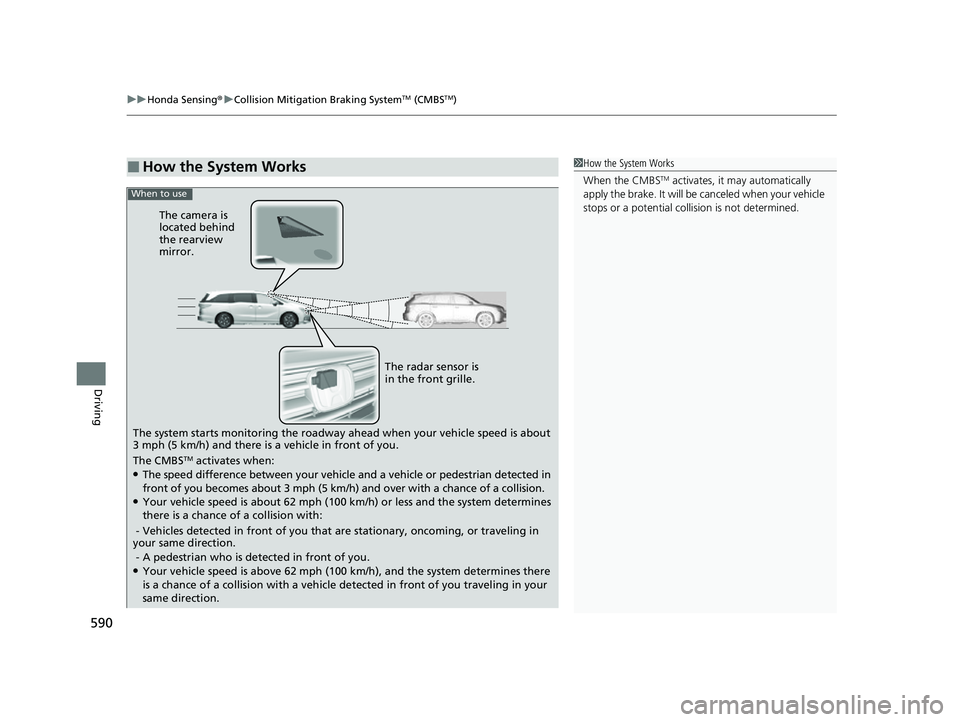
uuHonda Sensing ®u Collision Mitigation Braking SystemTM (CMBSTM)
590
Driving
■How the System Works1How the System Works
When the CMBS
TM activates, it may automatically
apply the brake. It will be canceled when your vehicle
stops or a potential coll ision is not determined.When to use
The camera is
located behind
the rearview
mirror.
The radar sensor is
in the front grille.
The system starts monitoring the roadway ahead when your vehicle speed is about
3 mph (5 km/h) and there is a vehicle in front of you.
The CMBS
TM activates when:●The speed difference between your vehicle and a vehicle or pedestrian detected in
front of you becomes about 3 mph (5 km/h) and over with a chance of a collision.
●Your vehicle speed is about 62 mph (100 km/h) or less and the system determines
there is a chance of a collision with:
- Vehicles detected in front of you that are stationary, oncoming, or traveling in
your same direction.
- A pedestrian who is detected in front of you.
●Your vehicle speed is above 62 mph (100 km/h), and the system determines there
is a chance of a collision with a vehicle detected in front of you traveling in your
same direction.
22 US ODYSSEY-31THR6400.book 590 ページ 2020年11月16日 月曜日 午後1時41分
Page 596 of 782
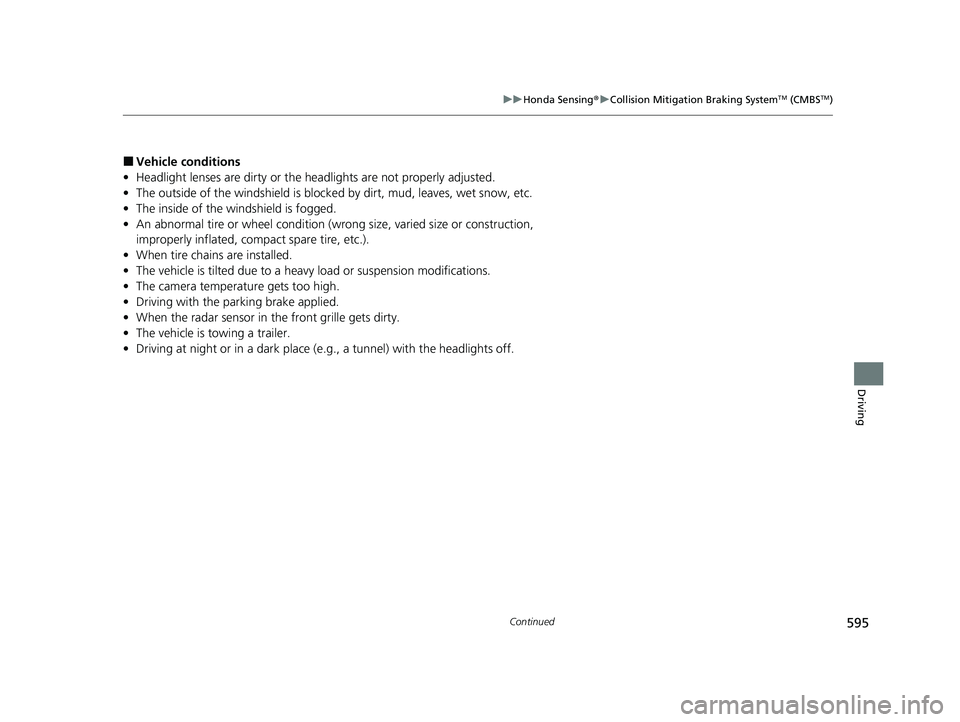
595
uuHonda Sensing ®u Collision Mitigation Braking SystemTM (CMBSTM)
Continued
Driving
■Vehicle conditions
• Headlight lenses are dirty or the h eadlights are not properly adjusted.
• The outside of the windshield is blocked by dirt, mud, leaves, wet snow, etc.
• The inside of the windshield is fogged.
• An abnormal tire or wheel condition (wrong size, varied size or construction,
improperly inflated, co mpact spare tire, etc.).
• When tire chains are installed.
• The vehicle is tilted due to a heavy load or suspension modifications.
• The camera temperature gets too high.
• Driving with the parking brake applied.
• When the radar sensor in the front grille gets dirty.
• The vehicle is towing a trailer.
• Driving at night or in a dark place (e.g., a tunnel) with the headlights off.
22 US ODYSSEY-31THR6400.book 595 ページ 2020年11月16日 月曜日 午後1時41分
Page 597 of 782
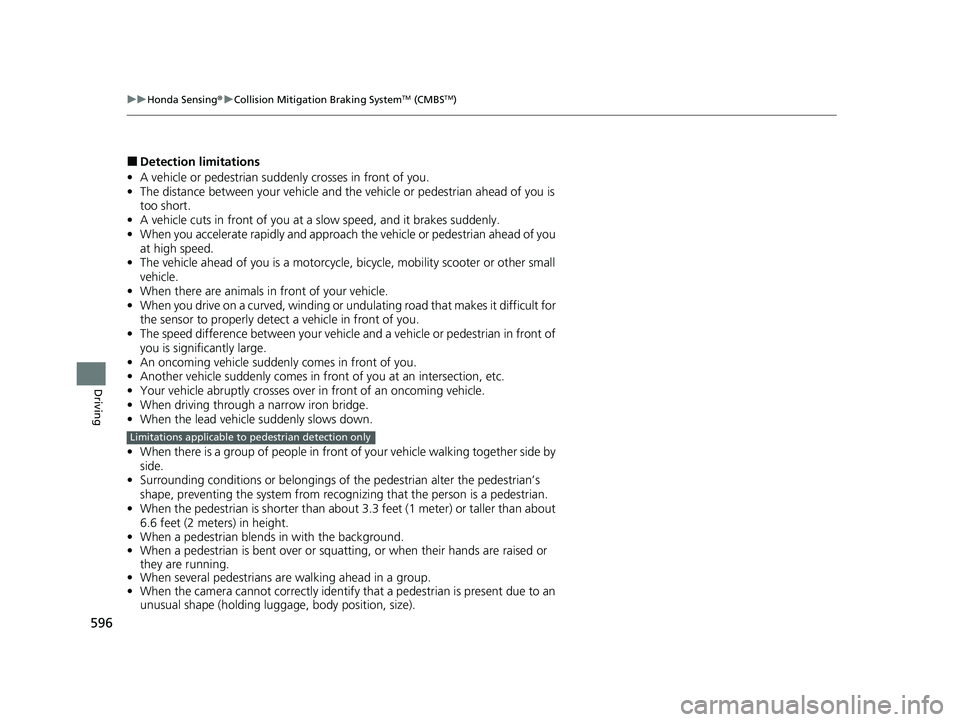
596
uuHonda Sensing ®u Collision Mitigation Braking SystemTM (CMBSTM)
Driving
■Detection limitations
• A vehicle or pedestrian suddenly crosses in front of you.
• The distance between your vehicle and the vehicle or pedestrian ahead of you is
too short.
• A vehicle cuts in front of you at a slow speed, and it brakes suddenly.
• When you accelerate rapidly and approach the vehicle or pedestrian ahead of you
at high speed.
• The vehicle ahead of you is a motorcycle, bicycle, mobility scooter or other small
vehicle.
• When there are animals in front of your vehicle.
• When you drive on a curved, winding or undulating road that makes it difficult for
the sensor to properly detect a vehicle in front of you.
• The speed difference between your vehicle an d a vehicle or pedestrian in front of
you is significantly large.
• An oncoming vehicle suddenly comes in front of you.
• Another vehicle suddenly comes in front of you at an intersection, etc.
• Your vehicle abruptly crosses over in front of an oncoming vehicle.
• When driving through a narrow iron bridge.
• When the lead vehicle suddenly slows down.
• When there is a group of people in front of your vehicle walking together side by
side.
• Surrounding conditions or belongings of the pedestrian alter the pedestrian’s
shape, preventing the system from recogn izing that the person is a pedestrian.
• When the pedestrian is shorter than about 3.3 feet (1 me ter) or taller than about
6.6 feet (2 meters) in height.
• When a pedestrian blends in with the background.
• When a pedestrian is bent over or squa tting, or when their hands are raised or
they are running.
• When several pedestrians are walking ahead in a group.
• When the camera cannot correctly identify that a pedestrian is present due to an
unusual shape (holding luggage, body position, size).
Limitations applicable to pedestrian detection only
22 US ODYSSEY-31THR6400.book 596 ページ 2020年11月16日 月曜日 午後1時41分
Page 601 of 782
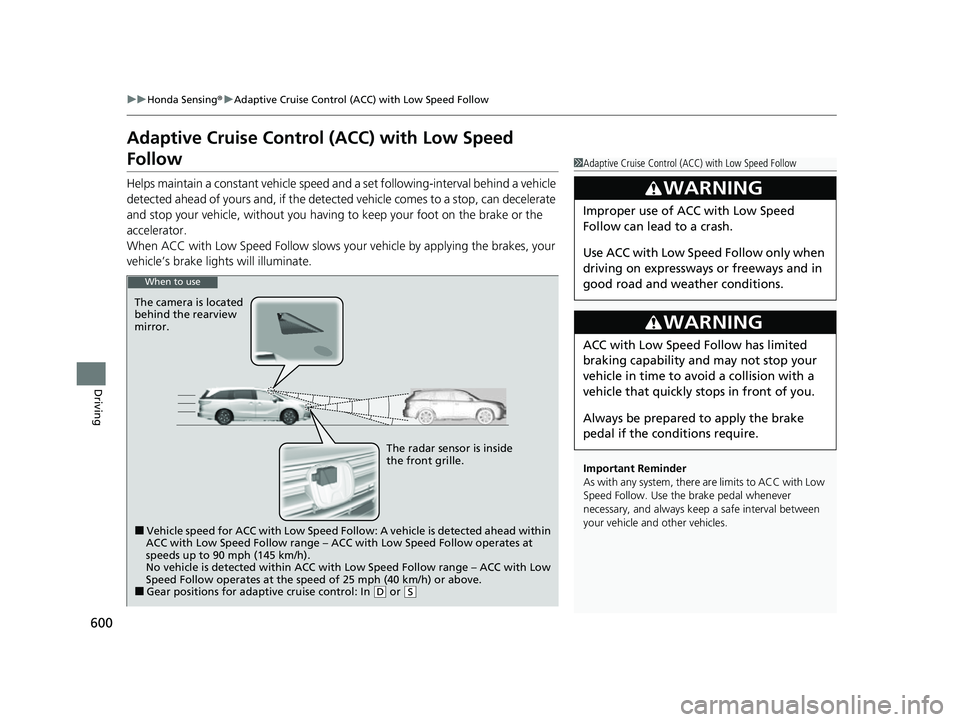
600
uuHonda Sensing ®u Adaptive Cruise Control (ACC) with Low Speed Follow
Driving
Adaptive Cruise Control (ACC) with Low Speed
Follow
Helps maintain a constant vehicle speed a nd a set following-interval behind a vehicle
detected ahead of yours and, if the detect ed vehicle comes to a stop, can decelerate
and stop your vehicle, without you having to keep your foot on the brake or the
accelerator.
When ACC with Low Speed Follow slows y our vehicle by applying the brakes, your
vehicle’s brake lights will illuminate.
1 Adaptive Cruise Control (ACC) with Low Speed Follow
Important Reminder
As with any system, there are limits to ACC with Low
Speed Follow. Use the brake pedal whenever
necessary, and always keep a safe interval between
your vehicle and other vehicles.
3WARNING
Improper use of ACC with Low Speed
Follow can lead to a crash.
Use ACC with Low Speed Follow only when
driving on expressways or freeways and in
good road and weather conditions.
3WARNING
ACC with Low Speed Follow has limited
braking capability and may not stop your
vehicle in time to avoid a collision with a
vehicle that quickly stops in front of you.
Always be prepared to apply the brake
pedal if the conditions require.
When to use
The camera is located
behind the rearview
mirror.
The radar sensor is inside
the front grille.
■Vehicle speed for ACC with Low Speed Follow: A vehicle is detected ahead within
ACC with Low Speed Follow range – ACC with Low Speed Follow operates at
speeds up to 90 mph (145 km/h).
No vehicle is detected within ACC with Low Speed Follow range – ACC with Low
Speed Follow operates at the speed of 25 mph (40 km/h) or above.
■Gear positions for adaptive cruise control: In ( D or (S
22 US ODYSSEY-31THR6400.book 600 ページ 2020年11月16日 月曜日 午後1時41分